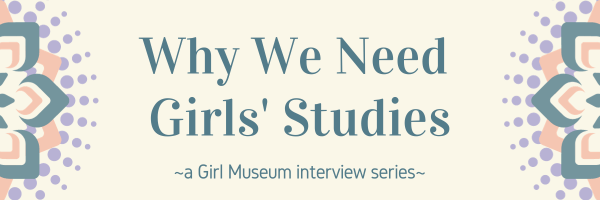
Welcome to the third instalment of Girl Museum’s interview series, Why We Need Girls’ Studies, for 2024. We have many exciting interviews this year with important scholars in the field to get insights about what we are all doing in this space to further our understanding of girlhood and girls’ experiences.
This month’s interview is with Shauna Pomerantz, she is a Professor of Child and Youth Studies at Brock University, Canada. She writes on the relationships and interaction of girls and creativity with social media and technology and has a wide range of research interests including media studies, youth studies, girlhood studies, popular culture, gender and education, intersectionality, social justice, qualitative inquiry, and feminist, poststructural, and posthuman theories.

Why do you consider it important to study girlhood?
First, just wild props from me to all those who have done this interview before. Reading them was a wonderful tracing of issues and movements in Girlhood Studies. From the mid-90s until present day, Girlhood Studies has undergone enormous change. It is obvious that Girlhood Studies people have read their own critiques and have worked to expand the field beyond just one “kind” of girl, including giving attention to age (focusing on younger girls and not just teens), racialization (most initial studies were done with white, suburban girls), class (an under-theorized and overlooked category), sexuality (“Are queer girls, girls?,” asked Marnina Gonick), and gender identity (untethering girlhood from biology). Girlhood Studies has also, over time, incorporated new subject matter and drawn on cutting-edge theories and methodologies so as not to get stale. The field is always changing and growing in response to what girls are doing IRL, which is one of the coolest things about Girlhood Studies. It is never still.
Like the field itself, it is important to study girlhood because this social category continues to grow and change. As girls take up more space, make more noise, shape more popular trends, lead more underground movements, sing more songs, choreograph more TikTok dances, and protest more injustices, girls are increasingly on the forefront of re-designing society and culture. While initially studied by feminists because girls were ignored in all areas of life, girls are now both invisible and visible at the same time. Girlhood Studies can continue to highlight the invisibility of girlhoods in relation to sexism, sexual violence, racism, classism, heterosexism, cisnormativity, age, and other intersections that remain underrepresented, while at the same time exploring girls’ visibility as movers, shakers, and culture-makers.
Girlhood studies is a relatively new field, yet is rapidly changing. What are the biggest opportunities for those interested in studying girlhood?
The field of Girlhood Studies is on the map. It is now time to push its capacity further by continuing to dismantle binaries, representational stasis, and taken-for-granted notions about what and when girlhood is, and who a girl can or should be. I think there are endless opportunities to take “girl” and “girlhood” out of their comfort zones, along with Girlhood Studies researchers. There are also new frontiers to be studied almost daily on social media sites, such as TikTok and SnapChat, as well as internet sites, such as YouTube. To that end, more open-ended qualitative research would push Girlhood Studies into new terrain. There is lots of room to cast light on relevant urgencies in the lives of girls that are still unknown to adult researchers. Until we ask girls what’s going on, we really don’t know. To that end, we need to continue to enlist girls as co-researchers. I keep seeing articles in the New York Times and the Washington Post that highlight the struggles of girls today in relation to mental health, environmental despair, social media depressions, and peer dramas. I would love to see academic research that both follows up on these journalistic pieces and offers counternarratives or, better yet, narratives of complexity that challenge a simple binary of “good” versus “bad” girl activities or “happy” versus “sad” girl existences. Nuance is often missing in broader media representations and Girlhood Studies can take the time to do deeper dives.
What is the biggest challenge facing girlhood studies? Do you have ideas on how we can address it?
As I mentioned in my previous answer, I think the biggest challenge is allowing for nuance, where we get to hear about girls’ negotiations of the world without adult-journalist-researcher polish or judgement. Addressing this challenge may entail engaging in research with girls as collaborators rather than participant subjects, so they can help to steer discussion and write interpretations of things in a way that honours their lived, messy, complex experiences. My daughter and I engaged in a collaborative post qualitative inquiry on TikTok, what it meant to her, and how it affected our family. It was so surprising and refreshing to embrace research that lacked a formal plan in lieu of following the conversation, her interests, and TikTok’s ridiculously fast-paced algorithm. I just hung on for dear life, but I learned so much about not just my daughter and her interests, but also about hierarchies in parenting and research. I was forever changed in these (for me) overlapping realms. When we start to think about “girls” and “girlhood” not as separate entities to be studied in isolation, but as affecting elements in broader constellations of meaning, Girlhood Studies will continue to grow into new areas of research, while becoming more interconnected with other fields.
Finally, please feel free to plug any current projects or publications that you want to highlight.
I recently wrapped up the TikTok study with my daughter that elicited three publications, two of which engaged immanent ontology and post qualitative inquiry, and one of which engaged feminist theorizing from Sara Ahmed and bell hooks. I am proud of these pieces because 1) they remind me of some good times we had together during the pandemic (which we sorely needed); 2) we worked as a team and the research ethics board at Brock university recognized the value of this type of adult-child collaboration; and 3) I learned some new and profound things both theoretically and methodologically that shifted the way I understood myself as “parent” and “researcher.”
I also have a book chapter coming out shortly in Sharon Mazzarella’s amazing new anthology, “The Routledge Companion to Girls’ Studies.” My chapter is titled, “Polaroid possibilities: Immanent girlhood and the tangle of temporality.” In it, I write about how Polaroids of my girlhood generated affect that lingered, causing me to feel the collision of past-present and to understand my girlhood as continuously happening rather than an event that ended when I became an adult.
Lastly, I am currently working on a paper for the Girlhood Studies Collective symposium, organized by the brilliant Halle Singh and E. Lev Fineman. The talk is called, “Girlhoods of War: Assemblages of Survival, Affect, & Play.”
